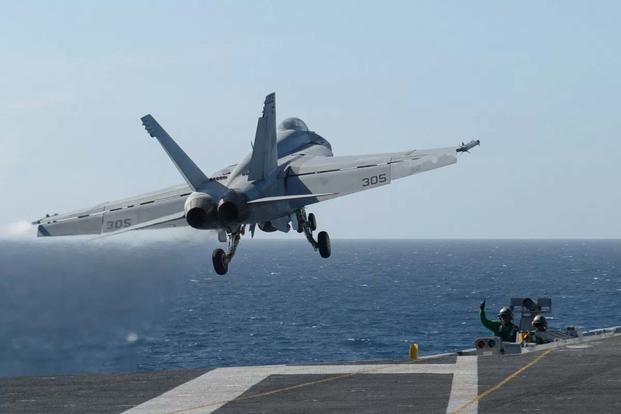The U.S. Navy has a new initiative to increase the reliability of its aging aircraft while improving its readiness level, the head of naval aviation said Friday.
"The hole's a little deeper than we thought," Vice Adm. DeWolfe Miller, head of the Naval Air Force and commander of Naval Air Force-Pacific, said during a panel discussion on naval aviation at the Center for Strategic & International Studies.
With recent budget boosts, the Navy will be able to restore its readiness levels, increasing flight hours and performing needed maintenance, he said. But "we didn't get here overnight, and we're not going to get out of here overnight."
As an example, Miller said the service's F/A-18 Super Hornet fleet is at about a 50 percent mission-capable rate, with roughly 260 aircraft ready to deploy at a moment's notice. He said the Navy must increase that number to at least 341 out of 546 total jets.
Related content:
- Air Force Sets Goal of 20 Flight Hours Per Month for Pilots
- Aviation Accident Spike Has Services Scrambling for Solutions
- Marines Go Bump In The Night: Bad Driving a Flightline Hazard
To do so, the service is implementing what it dubbed "The Navy Sustainment System" to increase spare parts, maintenance capability and lead time to maintain aircraft at a faster rate.
In August, Navy Secretary Richard V. Spencer told reporters that a similar effort, the Depot Readiness Initiative, is syncing depot maintenance and calendar or inspection maintenance to occur at the same time, stripping away hundreds of man hours on the same aircraft.
The Navy Sustainment System, meanwhile, brings in additional bodies to watch how maintainers perform.
"What's different this time is the expertise of the outside industry that we're bringing in," Miller said. "This is supported at the highest levels of the [Defense] Department, and that gives me confidence that if we … require changes in policy or law, that we will have complete support moving forward. This ... is a proven system" in the civilian airline industry.
The Navy is looking to its fleet readiness centers and depot supply chain to spearhead the effort, starting with the Super Hornet lines. Experts will tour fleet readiness centers, working with Navy counterparts on where they see inefficiencies in the system.
"It is going to leverage the best practices from commercial industries," Miller said.
The Marine Corps is planning comparable actions in sustainment and training, said Marine Lt. Gen. Steven Rudder, deputy commandant for aviation, adding that having defense industry engineers work with sailors and Marines may be a simple way to close gaps in maintenance issues with some "of these complex systems."
Increasing Flight Hours
As overall readiness improves, Rudder said the Corps' aviation flight hours are still "not where they should be," but they are steadily increasing.
"In [2016], our pilots were averaging 13.5 flight hours a month. In 2017, it was 15.4," he said. This year, "they're averaging 17.9. So our readiness is creeping up, and more importantly, we're becoming a more ready force."
Miller said the Navy has also increased its flight hours per pilot each month, but said it does not track flight hours the same way the Marine Corps does and could not provide specific figures.
"It's consistent with the number of airplanes that we have … but the trends are absolutely in the right direction," he said.
Addressing Aviation Mishaps
Military Times earlier this year reported that the Navy had the highest increase in aviation mishaps among the services, up 82 percent from fiscal 2013 through fiscal 2017.
The service's spike was largely due to Class C mishaps -- non-fatal accidents sustaining between $50,000 and $500,000 in damage to the aircraft. Class A mishaps include fatalities, severe damage totaling millions of dollars, or a complete loss of the aircraft.
The total number of Marine Corps aviation accidents also rose nearly 80 percent in that timeframe, from 56 to 101 per year, the report said. Most of this increase came in Class C mishaps, Military Times said.
"We had a terrible year last year," Rudder said. "This year, we cut our mishaps -- A, B and C -- in half. So we've actually had a great year, but we're still concerned, making sure the pilots are trained. … We want pilots to be proficient so they can react well to things that are unforeseen within aviation in the operating environment."
While not citing a specific number for 2018, he said ground accidents have also decreased by 50 percent. "It's pure supervision," he said, but added there have been a few "bumps in the night" on flightlines.
The Navy has not seen the same improvement, Miller said. "Class A and Class B mishaps are consistent with previous years, but our Class C aviation ground mishaps are going in the wrong direction. So it is clearly a focus area."
-- Oriana Pawlyk can be reached at oriana.pawlyk@military.com. Follow her on Twitter at @Oriana0214.










